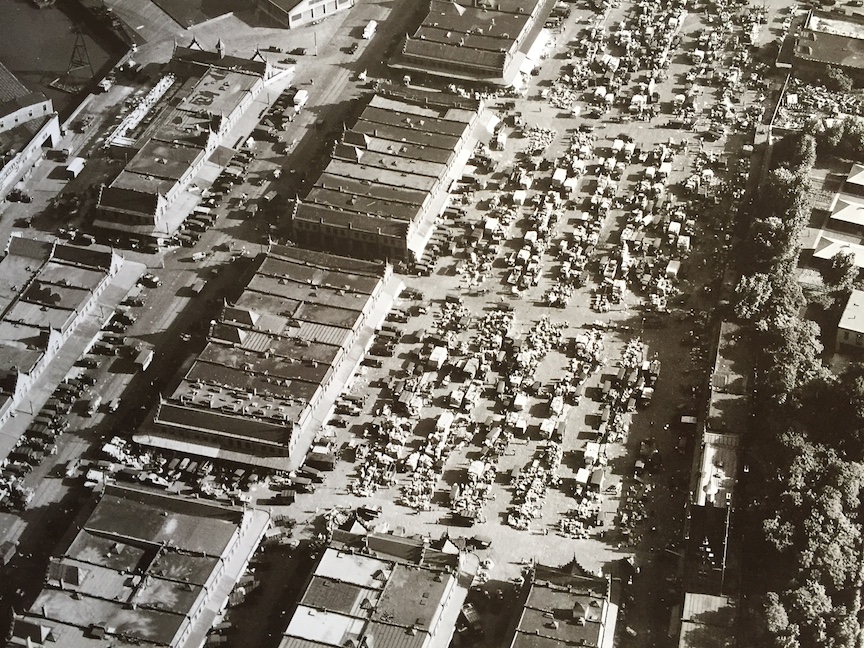WALLABOUT NAILS
I was cleaning the workshop this weekend and came upon these copper ten-penny nails, patinated to a lovely shade of green. We don’t generally expect history to dwell in something as ordinary as a nail, but these have a tale to tell. They were salvaged by my grandfather, who had a small grocery store at 96 Hudson Avenue in the 1930s, across from the west wall of the Brooklyn Navy Yard. He provisioned the place several times a week by wheeling a large cart to nearby Wallabout Market, where truck farmers from rural Brooklyn, Queens and Long Island hawked their produce (incidentally, the term “truck farm” derives from the French troque, to barter or trade, and has nothing to do with motor vehicles). Offended by waste in any form, my grandfather would gather the broken crates scattered and left behind in the fog of trade. Back home, he would pry out the nails that held the crates together, tapping and hammering each one straight and bundling them in little butcher-paper packets tied with string.

Wallabout Market occupied a narrow 50-acre site just above Flushing Avenue, between Wallabout Bay and the old Naval Hospital. It plugged into the city grid via Washington Avenue, which extended north into Williamsburg and south to Prospect-Lefferts Gardens, where it merged with Flatbush Avenue. The market’s origins date back to the 1880s, when residents of downtown Brooklyn began voicing opposition to the farm wagons that traditionally parked along lower Fulton and nearby streets to sell their goods. In September, 1884, city hall passed an ordinance banning such wagons from stopping along any thoroughfare other than Washington Avenue at Wallabout Bay. There, reported the Brooklyn Eagle, the city promised “a warm welcome from the people, a well lighted street, with suitable police protection, together with the earnest endeavor of the authorities to provide . . . a market place in some degree worthy of the magnitude of their mutual interests.” To facilitate trade in the interim, a series of wooden shacks and sheds were erected.

It took a full decade for the city to make good on its promise. In 1894, Brooklyn’s new Commissioner of City Works, Alfred T. White, took up the market cause, making Wallabout his pet project. White was a progressive visionary and housing reformer who helped found the Brooklyn Botanic Garden, donated land for Marine Park and created—in the Riverside Buildings on Columbia Place—worker housing so exceptional that Jacob Riis called them “a big village of contented people.” For the Wallabout project, White hired William Bunker Tubby, an Iowan who had studied architecture at Brooklyn Polytechnic Institute (today’s NYU Tandon School of Engineering). Tubby was a skilled historicist with a solid list of institutional and residential commissions under his belt—including several buildings for Pratt Institute. He chose the Flemish Revival style for Wallabout Market, a rare bird in New York City, and set his buildings in functional rows about a plaza called Farmer’s Square. Anchored by a soaring clocktower, Tubby’s plan was a masterpiece of civic urbanism—an Old-World market square straight out of the Hanseatic League. By the 1920s, Wallabout was one of the busiest produce markets in the world, the 1939 WPA Guide to New York describing it as “a solid mass of vehicles, crates, and barrels, and truck drivers, jobbers, and farmers.”

The loss of Wallabout Market was a tragic one for both cityscape and economy of north Brooklyn. Unlike so many borough landmarks, it was a victim not of urban renewal but war. As the world descended into armed conflict in the late 1930s, shipbuilding at the New York Naval Shipyard (as the Brooklyn Navy Yard was officially known) kicked into overdrive. Space was needed, and the market lay straight in the path of expansion. Tubby’s tower fell to the wrecking ball in the spring of 1941. More than 700 farmers, produce dealers, wholesale grocers and “butter-and-eggs men” were affected by the market’s closure. The expanded Navy Yard became the busiest shipyard in America, churning out an astonishing 17 vessels between 1940 and 1945 (including five aircraft carriers and three of the largest battleships ever built—the North Carolina, Iowa and Missouri.

War or not, Brooklynites still needed their vegetables, and so a new produce market had to be built. Sites were considered on Maspeth Avenue in Queens, at Flushing and Cypress Avenues in Bushwick, along Johnson Avenue at the head of Newtown Creek in East Williamsburg, on Linden Boulevard in East New York—where NYCHA’s Linden Houses are today. Eventually the city settled on a still-rural parcel at Foster Avenue and East 83rd Street in Canarsie for its new Brooklyn Terminal Market.
Demolition of Wallabout Market was already well underway when a farewell party was held on June 14, 1941. The event was presided over by Navy Yard Commandant Harold V. McKittrick and New York City Commissioner of Public Markets, William F. Morgan, Jr. Taps were played by a Navy bugler, speeches were made. McKittrick apologized to the Wallabout Market Merchants Association for the “patriotic inconvenience” he caused them. Afterward a “motor cavalcade” of some 500 cars and trucks set out across town for Brooklyn Terminal Market, a symbolic gesture of linkage between past and present, old and new.
Built in a rush and on a tight budget, the new Brooklyn Terminal Market lacked even a trace of old market’s urban-architectural splendor. It is still operating today as a market cooperative, well off the radar of gentrificant twee, self-described as “Brooklyn’s Best-Kept Secret.”

